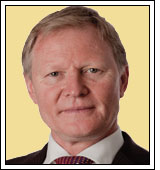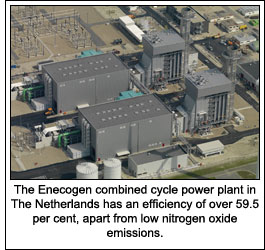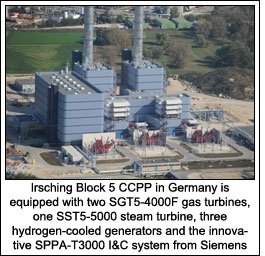 — Lothar Balling, Head of Gas Turbine Power Plant Solutions,
Fossil Power Generation Division, Siemens FACY
— Lothar Balling, Head of Gas Turbine Power Plant Solutions,
Fossil Power Generation Division, Siemens FACY, which stands for Fast Cycling, is a revolutionary technology
developed by Siemens for combined cycle gas-fired power plants.
This energy-efficient technology comes with a host of advantages,
the foremost being faster startups of power plants.
Lothar Balling
in an email interaction with
Venugopal Pillai discusses the FACY
technology in detail and explains its strong relevance to India.
FACY-equipped plants could even open possibilities of higher
revenues in the Indian spot electricity market, feels Balling.
Please explain in brief Siemens' FACY technology and elaborate
on the faster start-ups achieved by this technology.
FACY is the acronym of a summary of technologies to provide
fast cycling and start up capabilities. The development of this
technology feature had the target to increase the number of
allowable start/stop cycles, decrease the start-up and shutdown
time and at the same time keeping lifetime consumption
unchanged compared to conventional starts.
The implementation of the FACY concept in combination with
the hot start on-the-fly allows a hot start-up time reduction
down to 30 minutes and less, in comparison to "conventional"
hot starts mainly applied to Siemens 50Hz F-class and 50/60Hz
H- class combined cycle plants. The concept is based on a
procedure for parallel start-up of gas and steam turbines,
while monitoring and controlling the temperature gradients
within limits acceptable for all critical plant components. A new
start-up sequence, which avoids gas turbine load hold points,
was implemented. The main innovation here is the early steam
turbine starting point with earlier acceleration and loading of
the turbine.
FACY key features are:
- Utilization of different technologies like stack damper,
auxiliary steam etc. to maintain the pressure and
temperature in the main components during standstill
periods (as defined e.g. by hot start conditions)
- "Ready-for-operation" mode of the water/steam cycle by a
fully automated start up concept without manual operation
or intervention during hot start
- Optimized component design (e.g. high capacity and fast
acting de-superheaters) and plant operation to reduce
material fatigue caused by load cycling
- Flexible operation concept to allow the operator to
predetermine component fatigue and to choose start up time
and ramp rate
- Optimization of the automation and control concept
- Startup sequence "Start on the Fly" to allow early start of the
steam turbine
When was FACY introduced and how has it improved over time?
The need for increased flexibility first emerged at the end of the
1990s in the United States and the United Kingdom. The price of
fuel continued to rise due to the large number of plants being
built during the boom. Plants initially planned to have a baseload
role were shifted to the regime of an intermediate load
plant.
The challenge presented to projects by this changed
requirement gave birth to the idea to try to improve plant
flexibility without compromising plant service life or plant
efficiency.
As the market continued to develop, a demand for quicker
start-ups soon followed the demand for more frequent startups.
This market demand finally resulted in the launch by
Siemens of a development project called FACY which combined
all the initial engineering ideas into a single integrated plant
concept. The aim of the resulting R&D program, started in 2000
was to design a plant for an increased number of starts and to
reduce start-up times. If possible, no limits were to be placed
on the gas turbine by other power plant components, such as
the heat recovery steam generator or steam turbine, during hot
and warm starts. In the course of the project, potential areas
came to light where further optimization could be achieved,
although these had to wait for a second development
generation to be implemented.
The major improvement offered by this second generation
involved the start-up procedure. Hold points at which a plant
waits until certain steam parameters have been reached were
eliminated as part of the shortened "start on the fly" start-up
procedure. In this procedure, the steam turbine is started up in
parallel to the gas turbine using the first steam which becomes
available after a hot start. While the first generation FACY
reduced start-up times for a hot start from 100 to 55 minutes,
the second generation succeeded in pushing start-up times
down below the 40 minute mark. The first plants incorporating
the features of both the first and second generations of the
FACY concept have now entered commercial operation and are
meanwhile reaching the 30-minute level.
 Technically, gas-based power plants offer a better alternative
to coal-fired plants and nuclear plants. What is your view and
how can FACY strengthen the preference for gas-fired plants?
Technically, gas-based power plants offer a better alternative
to coal-fired plants and nuclear plants. What is your view and
how can FACY strengthen the preference for gas-fired plants?
Besides having the highest efficiency and lowest CO2
emissions of any thermal power plant technology, combined
cycle power plants are able to offer highly flexible solutions
that can accommodate sharp fluctuations in power
consumption. FACY delivers essential benefits in that the
technology helps maintain grid stability, enables power on
demand, and raises the efficiency during start-up process, thus
reducing costs of gas-fired power generation.
We recently came across "Flex" technology by Siemens, also
used in combined cycle gas power plants. What is the basic
difference?
Siemens Flex-Plant Technology enables a combined cycle to
start fast, load following, and sets the standard in transient
emissions, with Clean-Ramp features similar like FACY.
Siemens Flex-Plant portfolio is responsive, reacting to market
opportunities, allowing a combined cycle power plant to
respond like a peaker and was developed for the US market.
Siemens Flex-Plant portfolio is designed around the SGT6-
5000F gas turbine, and is now also offered around the world
class gas turbine SGT6-8000H. Fast Cycling is one aspect of the
Flex-Plant Solutions Portfolio.
How do you see the market for FACY in India, given that the
country is not exactly comfortable with gas supplies?
As flexibility, power on demand and fuel efficiency are essential
factors for profitable power generation, FACY ensures to make
power plants "future-proof". The implementation of FACY is not
linked with the gas availability. We definitely see a market perspective for high-efficiency combined cycle power plants in
India, starting 2014. And the new power plant projects should
ensure grid stability today and tomorrow and this is why they
should be equipped with FACY.
There will be a peaking demand in the future, which will not
be optimally covered by small simple cycle power plants due to
a comparably unattractive specific investment and a low
efficiency level. Especially in India, where the gas prices are
expected to rise dramatically in the future, irrespective of
domestic gas or imported LNG. FACY technology will help the
power plant operator optimize his OPEX, while at the same time
support the grid demands.
We are able to operate our combined cycle power plantsoriginally
optimized for base load- as intermediate load power
plants right up to daily starters and peakers with reserves and
operating flexibility. As discussed earlier, FACY helps to save
expensive fuel during start-up and shut-down; increases
average efficiency by 14 percentage points (SGT-8000H gas
turbine series) during start-up and allows providing load on
demand.
Tell us about some key FACY technology-based projects built
around the world.
Some examples would be:
- Pont sur Sambre, France
- Sloe Centrale, Netherlands
- Marchwood, UK
- Pego, Portugal
- Enecogen, Netherlands
- Hemweg and Diemen, Netherlands
- Timelkam, Austria
- Emile Huchet, France
- Irsching 5, Germany
We understand that faster startups of FACY-based gas plants
make them an important "tertiary" power source. Please
elaborate and discuss its relevance in the short-term
electricity market.
Playing the spot market (tertiary reserve) is particularly
attractive for power plant operators, as it pays high prices for
last-minute power. Players on this market have to guarantee
that they are able to provide the offered power within 15
minutes of it being requested. The Siemens FACY solution
package makes it possible to address this market. About 40 per
cent of the rated output of a combined cycle power plant
equipped with FACY is available after only 15 minutes.
Currently we have ongoing R&D programs to further improve
the 40 per cent limit within 15 minutes.
 How would you rate the prospects for FACY in India, vis-à-vis
other emerging nations, and China, in particular?
How would you rate the prospects for FACY in India, vis-à-vis
other emerging nations, and China, in particular?
We see a mixed demand for base, intermediate and peak load.
In every case, power on demand is essential. FACY allows
reacting flexibly on market conditions, especially in India
where there is a possibility of higher revenues in the spot
market.
Combined cycle power plants equipped with latest
Siemens H-class gas turbine technology can cope with
fluctuating load. For example Delhi with more than 1 GW
peak load variation during a day (by approximately 2 GW
base load) shows a predictable demand pattern. Power
plant operators save fuel by starting fast rather than
running at part load at lower efficiency and higher
emissions. CCPP equipped with FACY deliver power
on demand.
Let's stay with the Delhi example and show how a SGT5-
8000H gas turbine base load plant with daily cycling capability
benefits the security of supply: 1 GW in Delhi can be covered by
two SCC5-8000H power plants, which operate on a daily startstop
mode and respectively operate on load following during
the day.
An example is the Ulrich Hartmann power plant in Irsching,
Germany, that operates in the same way and allows for optimal
efficiency, also during the start and stop phases.
Please share your short-term plans for promoting FACY
technology in India.
We are sharing our experience on FACY equipped power plants
during road shows and fairs in India (e.g. Power-Gen),
discussions with regulators, authorities and consultants.